Social landlords need a whole-picture perspective across their portfolio to ensure that any actions they take can deliver on new regulation, writes Nathan Ward, Channel Sales Development Manager, Ordnance Survey
Ensuring residents have a safe, affordable, and decent place to call home lies at the heart of what housing associations do.
Over the last 10 years there has been a real shift in conversations surrounding the adequacy of social housing and tragedies in the sector have understandably led to more government attention and focus.
The publication of the 2018 Social Housing White Paper was the first step towards clear targets for the sector and in July last year, the Social Housing Regulation Act, based on that paper, received royal assent to become law.

Now a reality, this new regulation gives social landlords the responsibility to know the condition of every home, ensure tenants are safe and respond to their queries promptly. All while giving social housing regulators new powers to act if social landlords aren’t meeting their commitments to residents.
The UK’s housing associations now have a legal obligation to effectively understand where each home is, not only to effectively communicate with each tenant, but to manage the maintenance of each property for now and into the future, to ensure safe homes.
This is against a backdrop of rising Housing Ombudsman complaints as families experience broader challenges with the cost-of-living, and at a time when housing associations are also being encouraged to reduce emissions. All while the government has committed to virtually eliminating the carbon emissions of all homes over the next 30 years.
Meeting all of these expectations requires a clear overarching strategy that supports ongoing maintenance, and required upgrades, while also safeguarding the experience of current tenants.
Social landlords need a whole-picture perspective across their portfolio to ensure that any actions they take can deliver on new regulation, meet tenants’ expectations, and remain cost-effective.

Location – the great connector of housing insights
Any strategy implemented to support this complex picture for social housing landlords will rely on data pinpointing where homes and tenants are. Housing associations must be able to know, for example, where buildings require new low-emission alternatives to boilers, where the most energy-saving upgrades can be made, and which tenants will be disrupted, to understand the impact and urgency of their actions.
Accurate location data underpins our understanding of all of the opportunities to improve homes as well as the exact tenants impacted. That is why it is an essential piece of any housing association’s strategic plan to ensure efforts are cost effective, synchronised and comply with the standards the Social Housing Regulation Act has set.
However, any insights based on location will only be as good as the data used. To benefit from the whole-picture perspective location data can provide, housing associations must ensure they are using an accurate, comprehensive and interoperable dataset. For example, often the data held by housing associations is incomplete or incorrect.
The address of properties may only use a postcode or may have been inputted in error and without validation, meaning that the data cannot be relied upon. To add to this, some addressing datasets are solely based on Royal Mail data, meaning that the information included is designed for delivering letters, but is not necessarily robust enough to form the basis of large-scale maintenance planning.
The first stage to gaining reliable insights from the data, is to validate and cleanse the property address data. Validating this data against an authoritative source such as AddressBase data from Ordnance Survey will add the definitive address, provide accurate X and Y coordinates, and add a Unique Property Reference Number (UPRN) to identify each property exactly, with no ambiguity.
It is also essential, to create the whole picture, that the data is interoperable and can integrate with other datasets such as legal ownership and energy performance information. AddressBase was made with this integration and connectivity in mind, and by using the UPRN this means that you don’t need specialist insight to access the data that can transform how you maintain buildings and liaise with tenants.
With these reliable data foundations in place, topographic information can also help to contextualise the location of properties to their real-world environment; locating waterways, transport routes, and relevant roads.
Datasets with building data showing the type of property, age, construction materials, and building structure can also be added to inform maintenance and repair decision-making.
This data combined with aerial imagery will allow every association to get an accurate picture of the timelines and the safety risks associated with any work that is being carried out, which in turn, can aid cost management for any maintenance or upgrade project, and reduce delays. Meaning that timings can match the tenants’ expectations.
In addition to planning for current activities, these technologies can support the forecasting of future projects to ensure ESG goals are reached, and future social housing planning is environmentally minded. This is essential as funding for social housing authorities is dependent on reaching emissions targets for new and current projects.
In short, data-rich platforms and datasets can empower housing associations and councils to make location-based decisions about specific assets, services, and tenants whilst simultaneously bringing in information about the environmental risks embedded in these decisions.
As the UK’s national mapping agency, Ordnance Survey a choice of specialist partners that can support a range of organisations, including social landlords, to find the right location data to meet their unique needs.
The social landlords that harness the opportunity to create a whole-picture perspective with these tools will be the ones to effectively navigate complexity to meet the expectations of new regulation, while identifying opportunities to unlock funding through clear sustainability planning.











No comments yet